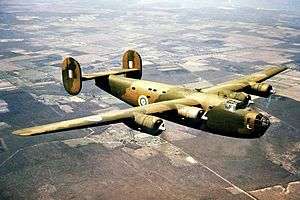No. 354 Squadron RAF
No. 354 Squadron RAF was a general reconnaissance squadron of the Royal Air Force during the Second World War.
| No. 354 Squadron RAF | |
|---|---|
 Consolidated Liberator | |
| Active | 10 May 1943 – 18 May 1945 |
| Country | |
| Branch | |
| Role | Reconnaissance |
| Part of | No. 225 Group RAF, South East Asia Command[1] |
| Insignia | |
| Squadron Codes | No identity markings are known to have been carried[2] |
| Aircraft flown | |
| Patrol | Consolidated Liberator |
| Reconnaissance | Consolidated Liberator |
History
No. 354 squadron was first formed at Drigh Road, Karachi on 10 May 1943 as part of Coastal Command, and was posted to RAF Station Cuttack on 17 August 1943, where it received Liberator Mk.V bombers. Detachments of the squadron were located at Sigiriya and St Thomas Mount. The squadron redeployed to Minneriya in Ceylon on 12 October 1944, with detachments at Kankesanturai and Cuttack, and returned to Cuttack whilst maintaining a detachment at Kankesanterai in January 1945, where they received the Liberator Mk.VI. The squadron was disbanded on 18 May 1945 at RAF Cuttack.
Aircraft operated
| From | To | Aircraft | Version |
|---|---|---|---|
| August 1943 | August 1944 | Consolidated Liberator | Mk.V |
| December 1943 | April 1944 | Consolidated Liberator | Mk.IIIa |
| February 1944 | May 1945 | Consolidated Liberator | Mk.VI |
Squadron airfields
| From | To | Airfield | Remark |
|---|---|---|---|
| 10 May 1943 | 17 August 1943 | RAF Drigh Road, Karachi | Formed here |
| 17 August 1943 | 12 October 1944 | RAF Cuttack, Orissa | Det. at Sigiriya, Ceylon and St Thomas Mount, Madras, Tamil Nadu |
| 12 October 1944 | 5 January 1945 | Minneriya, Ceylon | Det. at RAF Kankesanturai, Ceylon and Cuttack, Orissa |
| 5 January 1945 | 18 May 1945 | Cuttack, Orissa | Det. at Kankesanturai |
Commanding officer
| From | To | Name |
|---|---|---|
| July 1943 | May 1944 | W/Cdr. K.J. Mellor, DFC |
| May 1944 | March 1945 | W/Cdr. D.T. MacPherson |
| March 1945 | May 1945 | W/Cdr. F.G. Paisey |
gollark: I think three results in there sometimes being two possible points.
gollark: It's finding the intersection point of three/four spheres or something.
gollark: Sometimes you get errors with only three.
gollark: Oops, yes, editing.
gollark: Basically, it uses trilateration~~/triangulation~~ (https://en.wikipedia.org/wiki/True_range_multilateration), so you need three or sometimes four GPS servers.
References
Notes
- Delve 1994, p. 76.
- Rawlings 1982, p. 204.
- Halley 1988, p. 384.
- Jefford 2001, p. 90.
Bibliography
- Delve, Ken. The Source Book of the RAF. Shrewsbury, Shropshire, UK: Airlife Publishing, 1994. ISBN 1-85310-451-5.
- Gwynne-Timothy, John R.W. Burma Liberators: RCAF in SEAC. Toronto, Ontario, Canada: Next Level Press, 1991. ISBN 1-895578-02-7.
- Halley, James J. The Squadrons of the Royal Air Force & Commonwealth 1918–1988. Tonbridge, Kent, UK: Air Britain (Historians) Ltd., 1988. ISBN 0-85130-164-9.
- Jefford, C.G. RAF Squadrons, a Comprehensive record of the Movement and Equipment of all RAF Squadrons and their Antecedents since 1912. Shrewsbury, Shropshire, UK: Airlife Publishing, 1988 (second edition 2001). ISBN 1-85310-053-6.
- Oughton, James D. with John Hamlin and Andrew Thomas. The Liberator in Royal Air Force and Commonwealth Service. Tonbridge, Kent, UK: Air-Britain (Historians) Ltd., 2007. ISBN 978-0-85130-362-8.
- Rawlings, John D.R. Coastal, Support and Special Squadrons of the RAF and their Aircraft. London: Jane's Publishing Company Ltd., 1982. ISBN 0-7106-0187-5.
This article is issued from Wikipedia. The text is licensed under Creative Commons - Attribution - Sharealike. Additional terms may apply for the media files.
